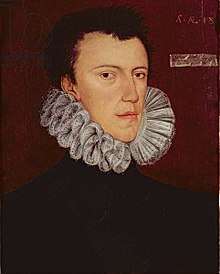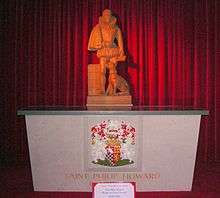Philip Howard, 13th Earl of Arundel
Saint Philip Howard, 13th Earl of Arundel (28 June 1557 – 19 October 1595) was an English nobleman. He was canonised by Pope Paul VI in 1970, as one of the Forty Martyrs of England and Wales. He is variously numbered as 1st, 20th or 13th Earl of Arundel.
The Earl of Arundel | |
|---|---|
 Lord Arundel aged 18, by George Gower | |
| Born | 28 June 1557 |
| Died | 19 October 1595 (aged 38) Tower Hill, London, England |
| Noble family | Howard |
| Spouse(s) | Anne Dacre |
| Issue | |
| Father | Thomas Howard, 4th Duke of Norfolk |
| Mother | Lady Mary FitzAlan |
Early life
Born in the Strand, London, he was the only child of Thomas Howard, 4th Duke of Norfolk by his first wife Lady Mary Fitzalan, daughter of Henry Fitzalan, 12th Earl of Arundel. He was baptised at Whitehall Palace with the royal family in attendance, and was named after his godfather, King Philip II of Spain.[1] Philip Howard was born during the upheaval of the Reformation. His home from the age of seven was a former Carthusian monastery.[2] At the age of fourteen he was married to his stepsister, Anne Dacre. He graduated from St John's College, Cambridge in 1574 and was about eighteen when he attended Queen Elizabeth I's court.[3] His life had been a frivolous one, both at Cambridge and at Court where he was a favourite of the Queen.
Philip Howard's father, the Duke of Norfolk, was arrested on 1 October 1569 for his intrigues against Queen Elizabeth. The Duke was attainted and executed in 1572, but Philip Howard succeeded to his mother's inheritance upon the death of his grandfather, becoming Earl of Arundel in 1580.[1] He was present at a debate held in 1581 in the Tower of London, between Father Edmund Campion, a Jesuit, Father Ralph Sherwin and a group of Protestant theologians.[3] He was so impressed by the Catholics that he experienced a spiritual conversion. He renounced his previous, frivolous life and was reconciled with his wife.
Conversion and imprisonment
Arundel and much of his family remained Catholic recusants during the reign of Queen Elizabeth I. He himself was suspected of disloyalty and regarded by the discontented Roman Catholics as the centre of the plots against the Queen's government, even as a possible successor.[4] His family also attempted to leave England without permission; while some might have been able to do this unobserved, Arundel was a second cousin (once removed) of the Queen. In 1583 he was suspected of complicity in the Throckmorton Plot and prepared to escape to Flanders but his plans were interrupted by a visit from Elizabeth at his house in London and her order that he confine himself there. In September 1584 he became a Roman Catholic, hiding his conversion and attempting next year once more to escape abroad.[5] He was betrayed by a servant and arrested not long after his ship set sail from Littlehampton.[6]
Howard was committed to the Tower of London on 25 April 1585.[1] He was charged before the Star Chamber with being a Roman Catholic, with quitting England without leave, sharing in Jesuit plots, and claiming the dukedom of Norfolk. He was sentenced to pay £10,000 and to be imprisoned during the queen's pleasure. In July 1586 his liberty was offered to him if he would carry the sword of state before the queen to church. In 1588 he was accused of praying, together with other Romanists, for the success of the Spanish Armada. He was tried for high treason on the 14th of April 1589, found guilty and condemned to death, but his sentence was not executed;[5] Queen Elizabeth never signed the death warrant, but Howard was not told this.[6] He was kept constantly in fear of execution, although comforted by the companionship of a dog, which served as a go-between by which Howard and other prisoners, most notably the priest Robert Southwell, could send messages to each other. Although these two men never met, Howard's dog helped them to deepen their friendship and exchange encouragement in each other's plight. Philip Howard loved his pet, who is remembered along with him in a statue at Arundel Cathedral.
One day Howard scratched into a wall of his cell these words: Quanto plus afflictiones pro Christo in hoc saeculo, tanto plus gloriae cum Christo in futuro ("the more affliction [we endure] for Christ in this world, the more glory [we shall obtain] with Christ in the next") (cf. Rom 8).[6]
Howard spent ten years in the Tower, until his death from dysentery. He petitioned the Queen as he lay dying to allow him to see his wife and his son, who had been born after his imprisonment. The Queen responded that "If he will but once attend the Protestant Service, he shall not only see his wife and children, but be restored to his honors and estates with every mark of my royal favor." To this, Howard is supposed to have replied: "Tell Her Majesty if my religion be the cause for which I suffer, sorry I am that I have but one life to lose." He remained in the Tower, never seeing his wife or daughter again, and died alone on Sunday 19 October 1595.[6] He was immediately acclaimed as a Catholic Martyr.
Howard was buried without ceremony beneath the floor of the church of St Peter ad Vincula, inside the walls of the Tower. Twenty-nine years later, his widow and son obtained permission from King James I of England to move the body to the Fitzalan Chapel located on the western grounds of Arundel Castle. Some of his bones are also found within his shrine at Arundel Cathedral.
Howard was attainted in 1589 for his mother's title, but his son Thomas eventually was restored in blood and succeeded as Earl of Arundel, and to the lesser titles of his grandfather.

Legacy
Saint Philip Howard is one of the patron saints of the Diocese of Arundel and Brighton.[2] Arundel Cathedral, originally known as the Church of St. Philip Neri, was commissioned by the 15th Duke of Norfolk in 1868. It was created a cathedral in 1965 and its dedication was changed to Our Lady and St. Philip Howard in October 1970. His tomb was moved to the cathedral in 1971[3] and remains a site of pilgrimage.
He was the author of a translation of An Epistle of Jesus Christ to the Faithful Soule by Johann Justus (1595, reprinted 1871) and of three manuscript treatises On the Excellence and Utility of Virtue.[5]
Ancestry
| Ancestors of Philip Howard, 13th Earl of Arundel | |||||||||||||||||||||||||||||||||||||||||||||||||||||||||||||||||||||||||||||||||||||||||||||||||||||||||||||||||||||||||||||||||||||||||||||||||||||||||||||||||||||||||||||||||||||||||||||||||||||||||||||||||||||||||||||||||||||||||||||||||||||||||||||||||||||||||||||||||||||||||
|---|---|---|---|---|---|---|---|---|---|---|---|---|---|---|---|---|---|---|---|---|---|---|---|---|---|---|---|---|---|---|---|---|---|---|---|---|---|---|---|---|---|---|---|---|---|---|---|---|---|---|---|---|---|---|---|---|---|---|---|---|---|---|---|---|---|---|---|---|---|---|---|---|---|---|---|---|---|---|---|---|---|---|---|---|---|---|---|---|---|---|---|---|---|---|---|---|---|---|---|---|---|---|---|---|---|---|---|---|---|---|---|---|---|---|---|---|---|---|---|---|---|---|---|---|---|---|---|---|---|---|---|---|---|---|---|---|---|---|---|---|---|---|---|---|---|---|---|---|---|---|---|---|---|---|---|---|---|---|---|---|---|---|---|---|---|---|---|---|---|---|---|---|---|---|---|---|---|---|---|---|---|---|---|---|---|---|---|---|---|---|---|---|---|---|---|---|---|---|---|---|---|---|---|---|---|---|---|---|---|---|---|---|---|---|---|---|---|---|---|---|---|---|---|---|---|---|---|---|---|---|---|---|---|---|---|---|---|---|---|---|---|---|---|---|---|---|---|---|---|---|---|---|---|---|---|---|---|---|---|---|---|---|---|---|---|---|---|---|---|---|---|---|---|---|---|---|---|---|---|---|---|
| |||||||||||||||||||||||||||||||||||||||||||||||||||||||||||||||||||||||||||||||||||||||||||||||||||||||||||||||||||||||||||||||||||||||||||||||||||||||||||||||||||||||||||||||||||||||||||||||||||||||||||||||||||||||||||||||||||||||||||||||||||||||||||||||||||||||||||||||||||||||||
See also
- Howard's great-grandson, also named Philip Howard, a Catholic cardinal.
References
- Pollen, John Hungerford. "Ven. Philip Howard." The Catholic Encyclopedia. Vol. 7. New York: Robert Appleton Company, 1910. 4 Apr. 2013
- Pastoral message of Bishop Cormac Murphy-O'Connor, 21 October 1995 Archived 3 July 2013 at Archive.today
- "St Philip Howard", Diocese of Arundel and Brighton
- Chisholm 1911, pp. 707-708.
- Chisholm 1911, p. 708.
- Homily of Cardinal Basil Hume, OSB, Arundel Cathedral, 25 October, 1995
Sources
- Brennan, Malcolm (1991). Martyrs of the English Reformation. Kansas City: Angelus Press. ISBN 978-0-935952-85-8. OCLC 981438995.CS1 maint: ref=harv (link)

- Sigrid Undset, Stages on the Road, copyright 1934.
- History Orb
- Philip Howard, 13th Earl of Arundel at the Encyclopædia Britannica
- Dewald, J.; Beik, W.; Blanning, T.C.W.; Feeney, D.; Hinds, S.; Simms, B. (1996). The European Nobility, 1400-1800. New Approaches to European History. Cambridge University Press. ISBN 978-0-521-42528-5. Retrieved 10 December 2018.CS1 maint: ref=harv (link)
| Peerage of England | ||
|---|---|---|
| Preceded by Henry Fitzalan |
Earl of Arundel Baron Maltravers 1580–1595 |
Succeeded by Thomas Howard |